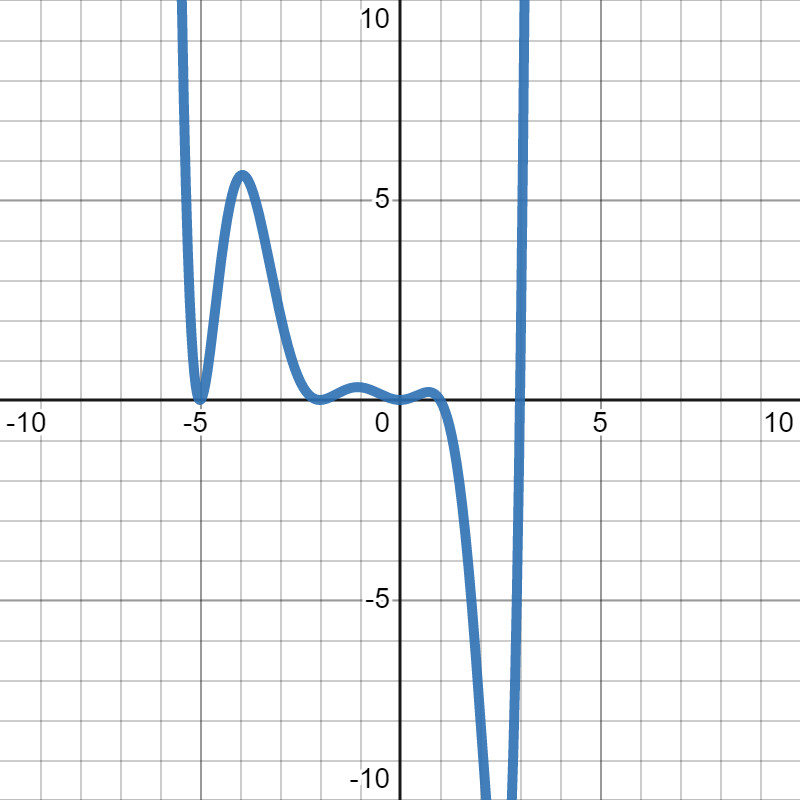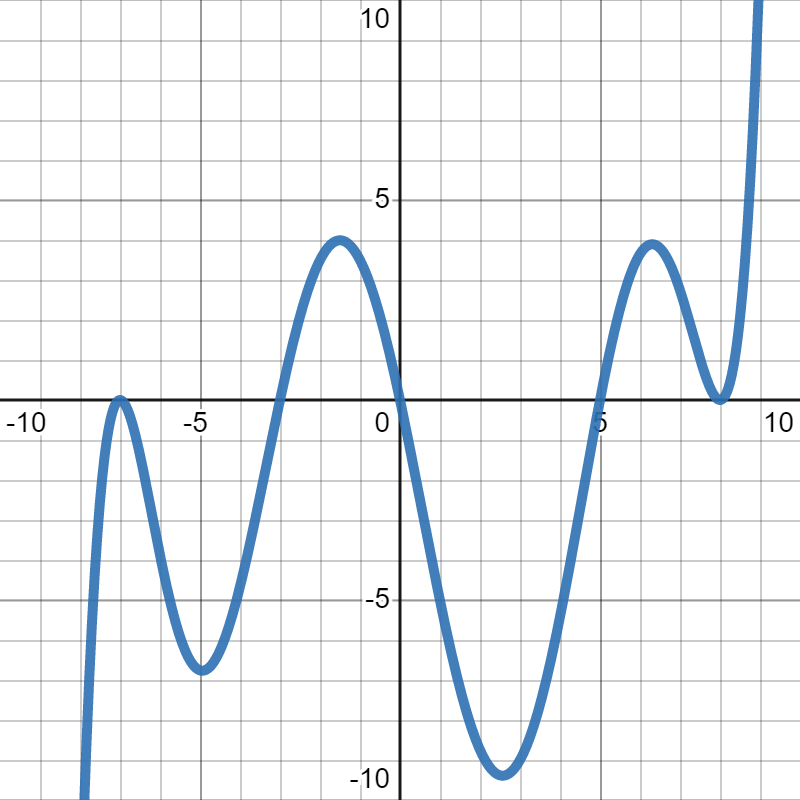Section 12.1 Roots of Polynomials
Definition 12.1.
The roots of a polynomial are the \(x\)-values of the \(x\)-intercepts. We also sometimes call these the zeros of the function.Example 12.2.
Suppose \(f(x)\) is the polynomial graphed below. We want to find the roots of that function.

We look at the \(x\)-axis, which crosses the graph at \(x=-5, -2, 0, 1\) and \(3\text{,}\) so those are our roots. The answer to this question is \(x=-5, -2, 0, 1, 3\text{.}\)
Checkpoint 12.3.
Suppose \(f(x)\) is the polynomial graphed below. What are the roots of that function?

Most of the time, we will be given an equation for the function, and we will need to do algebra to figure out what the roots are, rather than looking at a graph. Since we are just looking for the \(x\)-intercepts, we know from Section 1.2 just need to set \(y=0\) and solve for \(x\text{.}\) For quadratic functions, we had lots of strategies for solving these equations, but most of them were very specific to quadratics. The only one that will also work for polynomials is the Zero Product Property, which we saw in Example 11.4.
Example 12.4. Zero Product Property.
Suppose \(f(x)=-3x^4(x+5)^3(x-2)^7(x+8)^2\text{,}\) and we want to find its roots. As we always do with roots and \(x\)-intercept, we begin by setting \(y=0\text{,}\) so we need to solve the following equation:
Take a close look at the equation: we have a bunch of things multiplied together and it all equals 0. The fact that it equals 0 is special. There is no way to mulitply things together to get 0, unless one of the numbers you multiplied was already 0.
Why does that matter? Because we know one of the things we multiplied had to be 0 to begin with, this lets us separate our first equation into five separate equations:
The first equation doesn't have any \(x\) in it, and is nonsense since 3 does not equal 0. So that one doesn't help us, we'll ignore it. For the other four, we take roots and then add or subtract to solve. Since any root of 0 is still 0, we have four roots: \(x=0, -5, 2\text{,}\) and \(-8\text{.}\)
Checkpoint 12.5.
Suppose \(f(x)=-\frac{1}{2}(x+7)^3(x-2)^2(x-5)^7(x+1)^3(x+9)^9\text{.}\) What are the roots of \(f(x)\text{?}\)As we always do with roots and \(x\)-intercept, we begin by setting \(y=0\text{,}\) so we need to solve the following equation:
Just as we had with the example, we have a bunch of things multiplied together to be 0. That means one of them had to be zero to begin with. Because we know one of the things we multiplied had to be 0 to begin with, this lets us separate our first equation into six separate equations:
The first equation doesn't have any \(x\) in it, and is nonsense since \(-\frac{1}{2}\) does not equal 0. So that one doesn't help us, we'll ignore it. For the other five, we take roots and then add or subtract to solve. Since any root of 0 is still 0, we have five roots: \(x=-7, 2, 5, -1\text{,}\) and \(-9\text{.}\)
Subsection 12.1.1 Multiplicity
Definition 12.6.
If \(f(x)\) is a polynomial with a root \(x=r\text{,}\) then it has a factor of \((x-r)\text{.}\)
We saw this same definition when we discussed quadratic functions. However, quadratic functions only have two roots. Polynomials could have lots of roots, and some might be repeated. We saw this a little bit with quadratic functions in Example 11.16, but with polynomials in general, we could have even higher powers than 2.
Definition 12.7.
The multiplicity of a root of a polynomial is the number of times it is repeated. From the formula, we can tell the multiplicity by the power on the factor.
Example 12.8.
Let's look at the function we had before: \(f(x)=-3x^4(x+5)^3(x-2)^7(x+8)^2\text{.}\) We already know that it has roots \(x=0, -5, 2\text{,}\) and \(-8\text{.}\) To find the multiplicities, we just have to take the exponents of the factors that go with them. We can summarize this information in a table, like the one below:
| Root | Multiplicity |
| \(0\) | \(4\) |
| \(-5\) | \(3\) |
| \(2\) | \(7\) |
| \(-8\) | \(2\) |
Checkpoint 12.10.
Suppose \(f(x)=-\frac{1}{2}(x+7)^3(x-2)^2(x-5)^7(x+1)^3(x+9)^9\text{.}\) What are the roots of \(f(x)\) and their multiplicities?| Root | Multiplicity |
| \(-7\) | \(3\) |
| \(2\) | \(2\) |
| \(5\) | \(7\) |
| \(-1\) | \(3\) |
| \(-9\) | \(9\) |
We already know that it has roots \(x=-7, 2, 5, -1\text{,}\) and \(-9\text{.}\) To find the multiplicities, we just have to take the exponents of the factors that go with them. We can summarize this information in a table, like the one below:
| Root | Multiplicity |
| \(-7\) | \(3\) |
| \(2\) | \(2\) |
| \(5\) | \(7\) |
| \(-1\) | \(3\) |
| \(-9\) | \(9\) |
Now that we know how to find multiplicity from an equation, the logical question is: how do we find the multiplicity from a graph? The short answer is that you can't! Lots of different multiplicities look exactly the same on the graph, so we cannot tell the exact number of the multiplicity from the graph alone. However, we are not out of luck entirely. We can tell some information about the multiplicity from the graph.
Fact 12.13. Multiplicity from a Graph.
A root with even multiplicity bounces off of the \(x\)-axis.
A root with odd multiplicity goes through the \(x\)-axis.
That is the only information about the multiplicity we can tell from a graph. That means that if you are given just a graph and asked for the multiplicities, the answer is either the word "even" or "odd", the answer is not a number. We cannot tell the difference on a graph between multiplicity 2, 4, or 100, but we can tell the difference between 2 and 3.
Example 12.14.
Suppose \(f(x)\) is the polynomial graphed below. We want to find the roots of that function and their multiplicities.

We look at the \(x\)-axis, which crosses the graph at \(x=-5, -2, 0, 1\) and \(3\text{,}\) so those are our roots. Now, to find the multiplicity, we have to look at whether it bounces off the \(x\)-axis or crosses it. We can put all that information into the following table:
| Root | Multiplicity |
| \(-5\) | even |
| \(-2\) | even |
| \(0\) | even |
| \(1\) | odd |
| \(3\) | odd |
Checkpoint 12.16.
Suppose \(f(x)\) is the polynomial graphed below. What are the roots of that function and their multiplicities?

| Root | Multiplicity |
| \(-7\) | even |
| \(-3\) | odd |
| \(0\) | odd |
| \(5\) | odd |
| \(8\) | even |
We look at the \(x\)-axis, which crosses the graph at \(x=-7, -3, 0, 5\) and \(8\text{,}\) so those are our roots. Now, to find the multiplicity, we have to look at whether it bounces off the \(x\)-axis or crosses it. We can put all that information into the following table:
| Root | Multiplicity |
| \(-7\) | even |
| \(-3\) | odd |
| \(0\) | odd |
| \(5\) | odd |
| \(8\) | even |